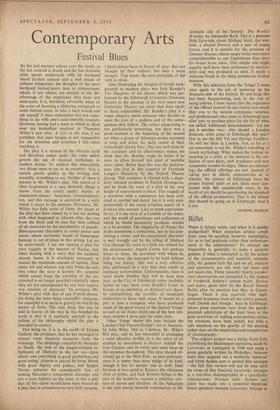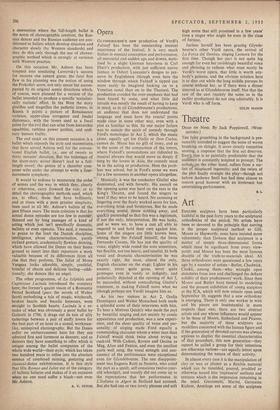Ballet
WHEN is failure noble, and when is it merely undignified? What minimum artistic condi-
tions must be satisfied, however imperfectly, for us to feel gratitude rather than embarrass- ment at the achievement? To attempt the
impossible is, generally, to make a quixotic gesture; if what is attempted is, by the nature of the circumstances and material, unrealis- able, the gesture falls flat and we all, creators and spectators, are left with red faces and not much else. These (possibly faintly ponder- ous) observations are prompted by the impact of Frederick Ashton's newest ballet, Romeo and Juliet, given here by the Royal Danish Ballet after its creation last May in Copen- hagen. There it was received with high- powered hosannas from all the critics present, both Danish and foreign: here in Edinburgh, where press reactions vary from the parish- pumpish adulations of the local boys to the grim acerbities of visiting metropolitan critics, the reactions have been mixed, but with a safe emphasis on the quality of the dancing rather than on the simplicities and complexities of choreography.
The original project was a ballet, fairly fully embodying the Shakespeare narrative, made by Lavrovsky in Leningrad in 1940 and using a score specially written by Prokoflev; between them they mapped out a workable 'scenario' and (from flashes seen in several film excerpts —the full film version will not be seen until the close of this Festival) Lavrovsky emerges as a top-class choreographer in a specifically contemporary Russian style. Romeo and Juliet was made into a powerful theatrical dance spectacle because Lavrovsky belongs in
a convention where the fa-length ballet is the norm of choreographic creation; the Rus- sian dancer and the Russian audience are con- ditioned to ballets which develop situation and character slowly (by Western standards) and they do this only through the use of choreo- graphic method which is strongly at variance with Western practice.
On this occasion Mr. Ashton has been tempted into emulating Lavrovsky's success for reasons one cannot guess; the fatal first flaw in his planning was the notion of using the Prokofiev score, not only uncut but accom- panied by its original scenic directions which, of course, were planned for a version of the ballet intended to produce a specific 'socialisti- cally realistic' effect. In the West the story glorifies and magnifies the pathetic lovers; in Russia it paints a picture of Renaissance violence, upper-class arrogance and feudal diplomacy, with the lovers used as a focal point for the evil that can arise from hierarchic squabbles, ruthless power politics, and ordi- nary human frailty.
The end result on this present occasion is a ballet which expands the style and mannerisms that have served Ashton well for the conven- tional English ballet, i.e., one of twenty to thirty minutes' duration. But the technique of the short-story writer doesn't lead to a full- length novel; the genius of a chamber com- poser wilts under the attempt to write a four- movement symphony.
It would be tedious to enumerate the order of scenes and the way in which they, clearly or otherwise, carry forward the tale; or to detail the choreographic methods used, which are, in effect, those that have brilliantly, and at times with a pure pristine simplicity, been used in all Mr. Ashton's ballets of the past fifteen years. The main criticism is that his actual dance episodes are too few in number; thinned out by long passages of a kind of acting which just isn't specifically dramatic, balletic or even operatic. This said, it remains to praise to the limit the Danish discipline, intelligence, about characterisation, purely 'stylised gesture, academically flawless dancing, which have allowed the Danes on their home ground to insert into their repertoire a work valuable because of its differences from all else that they perform. The Juliet of Mona Vangsaa looks adorable, simple, youthful, brimful of charm and delicate feeling—addi- tionally, she dances like an angel.
The other programme, of La Sylphide and Capricious Lucinda introduced the company here; the former's quaint vision of a Romantic Period Scotland (pace the novels of Walter Scott) embodying a tale of magic, witchcraft, broken hearts and bucolic humours, went straight to Scottish hearts. Lucinda is a re- make of what was obviously a poor ballet by Galeotti in 1796; it drags out its tale of silly natterings between a pair of stuffy lovers for the best part of an hour in a sound, workman- like, uninspired choreography. But the Danes suffer no embarrassment here for they are admired first and foremost as dancers; and as dancers they have something to offer which is unique among the ballet companies of the whole wide world—their style; which has taken two hundred years to refine into the absolute essence of combined miming, gesturing and classical-dance exhibitionism. It is this style that lifts Romeo and Juliet out of the category of balletic failures and makes of it an occasion when no one need suffer a blush—not even Mr. Ashton.
A. V. COTON



































 Previous page
Previous page